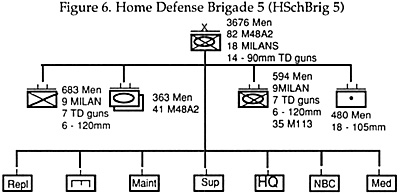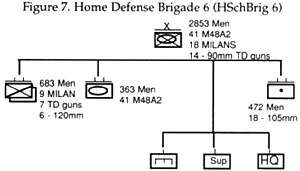To support the Field Army in time of war, the Bundeswehr has a second major organization: the Territorial Army. The Territorials are not committed formally to NATO and during a war they would remain under German command. The primary responsibility of the Territorial Army is to maintain the freedom of operation for NATO forces. One of the major missions of the Territorials in fulfilling this responsibility is to provide rear area security for the support assets of the frontline combat units. They are trained and armed to deal with airborne assaults., commando and sabotage raids, and enemy main force breakthroughs. Other missions include military movement control, engineering functions such as river crossings, damage repair, and explosive ordnance disposal, NBC (Nuclear,Biological, and Chemical) defense, psychological operations, and construction and operation of communications. They will also provide medical services to military and civilian personnel. Finally, they can be used as second echelon Field Army replacements and reinforcements.
The Territorial Army is organized into three territorial commands and five military districts. These districts are divided into 29 military regions and 80 subregion commands. The combat organizations within this command structure include 12 heavilyarmed Home Defense brigades, 15 light infantry Home Defense regiments, 150 security companies, and 300 security platoons.
The security companies and platoons are armed and equipped primarily to defend key fixed facilities and vulnerable targets, such as bridge sites, airfields, rail junctions, government offices, communication complexes, etc. The regiments provide general rear area security with their light infantry battalions and are capable of overwatching some 900 square miles of territory. These units cover and control the areas to be protected through continual reconnaissance and by occupying partial or temporary static positions on key terrain, possible drop zones, and critical road junctions. If a threat develops, the regiment must rapidly concentrate to contain and, if possible, defeat the enemy present.
 The Home Defense brigades provide most of the combat
power and punch to the Territorial Army. They are armed to be able
to meet and defeat enemy airborne assaults as well as armor
breakthroughs. There are two types of brigades currently in service.
The HSchBrig 5 (Home Defense Brigade, Type 5) is the larger of the
two types, carrying nearly 3700 men in its TO&E. As shown in
Figure 6, it is essentially a panzer brigade, with two tank battalions
(armed with M-48A2s), one mechanized infantry battalion (with M-
1 13 APCs), and a light infantry battalion (truckmobile), making up
its primary combat force. A battalion of towed 105mm howitzers
provides support. The brigade also contains engineers, logistics,
medical, and NBC companies, and is accompanied by a Field
Replacement battalion of almost 700 men. There are six F[SchBrig5
brigades in the Territorial Army.
The Home Defense brigades provide most of the combat
power and punch to the Territorial Army. They are armed to be able
to meet and defeat enemy airborne assaults as well as armor
breakthroughs. There are two types of brigades currently in service.
The HSchBrig 5 (Home Defense Brigade, Type 5) is the larger of the
two types, carrying nearly 3700 men in its TO&E. As shown in
Figure 6, it is essentially a panzer brigade, with two tank battalions
(armed with M-48A2s), one mechanized infantry battalion (with M-
1 13 APCs), and a light infantry battalion (truckmobile), making up
its primary combat force. A battalion of towed 105mm howitzers
provides support. The brigade also contains engineers, logistics,
medical, and NBC companies, and is accompanied by a Field
Replacement battalion of almost 700 men. There are six F[SchBrig5
brigades in the Territorial Army.
 The other type of brigade is the HSchBrig6 , a smaller,
truckmobile infantry brigade, organized as seen in Figure 7, and kept
at cadre level during peace time. There are two light infantry
battalions, armed with MILANs, mortars, and tracked 90mm anti-
tank destroyers. A battalion of M48A2 tanks and towed artillery
provide support for this brigade. Brigade assets are much more
limited with the HSchBrig6, including only engineers and logistics
personnel. There are six brigades of this type. Home defense brigades
are mobilization dependent, with only two brigades nearly fully-
manned during peacetime. These two brigades are under the
operational control of the Field Army. Of the other Home Defense brigades, there are two manned at 65% of wartime strength, two at 52%, and the other six are equipment pools only.
The other type of brigade is the HSchBrig6 , a smaller,
truckmobile infantry brigade, organized as seen in Figure 7, and kept
at cadre level during peace time. There are two light infantry
battalions, armed with MILANs, mortars, and tracked 90mm anti-
tank destroyers. A battalion of M48A2 tanks and towed artillery
provide support for this brigade. Brigade assets are much more
limited with the HSchBrig6, including only engineers and logistics
personnel. There are six brigades of this type. Home defense brigades
are mobilization dependent, with only two brigades nearly fully-
manned during peacetime. These two brigades are under the
operational control of the Field Army. Of the other Home Defense brigades, there are two manned at 65% of wartime strength, two at 52%, and the other six are equipment pools only.
Between the Field Army and the Territorial Army, the Bundeswehr fields some 340,000 troops during peacetime. Mobilization will essentially triple this number to over 1,000,000. In all, the Bundeswehr constitutes a modern and formidable force.
NATO's basic strategic doctrine is the Flexible Response, which attempts to insure that the enemy's chances for success are less than the risk of defeat or escalation. The doctrine calls for inplace conventional forces strong enough to deter an immediate invasion and to force the Soviets into a significant build-up prior to an attack. NATO expects such a build-up would be detected by intelligence and strategic reconnaissance, providing time for the Allies to mobilize.
More Bundeswehr Mission, Organization, and Doctrine
Back to Table of Contents: CounterAttack #1
To CounterAttack List of Issues
To MagWeb Master Magazine List
© Copyright 1987 by Pacific Rim Publishing Company.
This article appears in MagWeb (Magazine Web) on the Internet World Wide Web.
Other military history articles and gaming articles are available at http://www.magweb.com